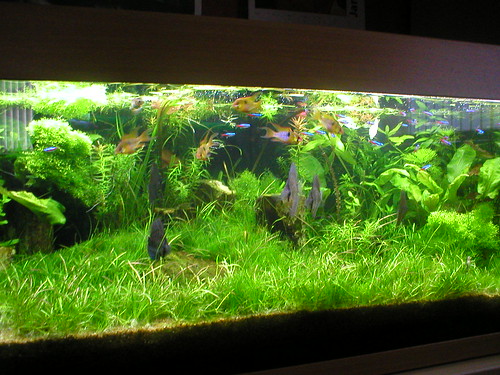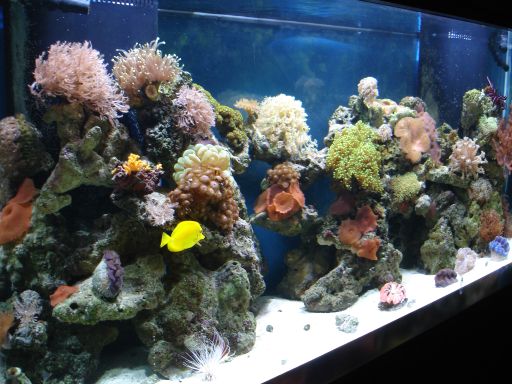An aquarium (plural aquariums or aquaria) is a vivarium consisting of at least one transparent side in which water-dwelling plants or animals are kept. Fishkeepers use aquaria to keep fish, invertebrates, amphibians, marine mammals, turtles, and aquatic plants. The term combines the Latin root aqua, meaning water, with the suffix -arium, meaning "a place for relating to".An aquarist owns fish or maintains an aquarium, typically constructed of glass or high-strength plastic. Cuboid aquaria are also known as fish tanks or simply tanks, while bowl-shaped aquaria are also known as fish bowls. Size can range from a small glass bowl to immense public aquaria. Specialised equipment maintains appropriate water quality and other characteristics suitable for the aquarium's residents.

Acrylic aquaria are also available and are the primary competitor with glass. Acrylics are stronger than glass, and much lighter. Acrylic-soluble cements are used to directly fuse acrylic together (as opposed to simply sealing the seam). Acrylic allows for the formation of unusual shapes, such as hexagonal. Compared to glass, acrylics are easy to scratch; care must be taken with organisms with shells and teeth.
Laminated glass might be used, which combines the advantages of both glass and acrylic.Large aquaria might use stronger materials such as fiberglass-reinforced plastics. However, this material is not transparent.Reinforced concrete is used for aquaria where weight and space are not factors. Concrete must be coated with a waterproof layer to prevent the water from breaking down the concrete as well as prevent contamination from the concrete.
Styles
Aquariums have been fashioned into coffee tables, sinks, and even toilets. Another such example is the Macquarium, an aquarium made from the shell of an Apple Macintosh computer.
A kreisel tank is a circular aquarium designed to hold delicate animals such as jellyfish. These aquariums provide slow, circular water flow with a lack of physical objects.Originally a German design (kreisel means spinning top), the tank has no sharp corners, and keeps the housed animals away from the plumbing. Water moving into the tank gives a gentle flow that keeps the inhabitants suspended, and water leaving the tank is covered by a delicate screen that prevents the inhabitants from getting stuck. There are several types of kreisel tanks. In a true kreisel, a circular tank has a circular, submerged lid. Pseudokreisels have a curved bottom surface and a flat top surface, similar to the shape of either a "U" or a semicircle. It is possible to combine these designs; a circular shaped tank is used without a lid or cover, and the surface of the water acts as the continuation of circular flow.


Components
Combined biological and mechanical aquarium filtration systems are commonly used. These are designed to either convert ammonia to nitrate (removing nitrogen being at the expense of aquatic plants), or to sometimes remove phosphate from water. Particulates incorporated into the filter can provide energy for microbes and sponges that do things like nitration.
Aquarium heaters combine a heating element with a thermostat, allowing an aquarist to regulate water temperature at a level above that of the surrounding air, whereas coolers and chillers (refrigeration devices) are for use in cold water aquaria, or anywhere the ambient room temperature is above the desired tank temperature. Thermometers used include glass alcohol thermometers, adhesive external plastic strip thermometers, and battery-powered LCD thermometers. In addition, some aquarists use air pumps attached to airstones or water pumps to increase water circulation and supply adequate gas exchange at the water surface.
An aquarium can be placed on an aquarium stand. Because of the weight of the aquarium, a stand must be strong as well as level. A tank that is not level may distort, leak, or crack. These are often built like cabinets to allow storage, available in many styles so it can match room decor. Simple metal tank stands are also available. Most aquaria should be placed on polystyrene to cushion any irregularities on the underlying surface or the bottom of the tank itself.




No comments:
Post a Comment